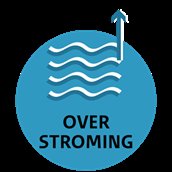What is the probability of flooding in the Netherlands?
The probability of flooding is highest along the major rivers in low-lying polders and in Limburg. However, regional rivers and brooks can also overflow. The paragraphs below explain how sharply water levels may rise as a result of climate change. We also provide some guidelines on exploring the vulnerability of an area to flooding.
How sharply will water levels rise?
The Increase in Water Levels map narrative in the Climate Impact Atlas outlines the projected long-term rise in water levels and what is needed to keep our flood defences strong. It also shows how strengthening the defences shape our choices in spatial planning and land use.
How can the flood characteristics of an area be explored?
Are you interested in exploring an area’s flood characteristics? Your first step may be to view flood depth maps in the Climate Impact Atlas. The Flood Depth map narrative contains maps indicating, for the current situation, the potential depth to which an area may be flooded. The flood depth is of major relevance to the extent of the damage and the number of victims. Your second step may be to view the Flood Risks and Flood Impact Reduction map narrative. The associated map shows, for each area, the probability of a particular flood depth occurring. This produces some initial leads regarding the feasibility and affordability of measures.
The Climate Impact Atlas contains several types of maps offering reliable basic information on the vulnerability to flooding of different areas in the Netherlands. The Stress Test Guidelines explain how to use these maps, in order to gain an initial picture of an area’s vulnerability to flooding.
